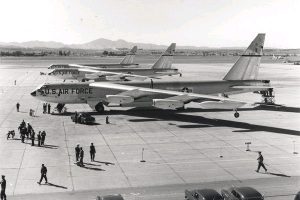 We all look for firsts in things, like first steps, first words, first man in space, first man on the moon, and in this case, the first around the world flight of a jet engine. You would expect that it might be some new jet, designed by an aviation expert, and you would be right, but the flight in question happened on January 16, 1957. The plans were three Boeing B-52 Stratofortresses. This was not just a flight for the purpose of setting a record, but rather it was a flight designed to prove a very important point. The operation was called Operation Power Flite…I’m not sure why flight was spelled flite. The planes made the trip around the world in 45 hours and 19 minutes, using in-flight refueling so that they could stay aloft for the entire journey. The mission was intended to demonstrate that the United States had the ability to drop a hydrogen bomb anywhere in the world. Led by Major General Archie J. Old, Jr. as flight commander, five B-52B aircraft of the 93rd Bombardment Wing of the 15th Air Force took off from Castle Air Force Base in California on January 16, 1957, at 1:00 PM, with two of the planes flying as spares. Old was aboard Lucky Lady III (serial number which was commanded by Lieutenant Colonel James H. Morris, who had flown as the co-pilot aboard the Lucky Lady II when it made the world’s first non-stop circumnavigation in 1949. Heading east, one of the planes was unable to refuel successfully from a Boeing KC-97 Stratofreighter and was forced to land at Goose Bay Air Base in Labrador. The second spare refueled with the rest of the planes over Casablanca, Morocco and then split off as planned to land at RAF Brize Norton in England.
We all look for firsts in things, like first steps, first words, first man in space, first man on the moon, and in this case, the first around the world flight of a jet engine. You would expect that it might be some new jet, designed by an aviation expert, and you would be right, but the flight in question happened on January 16, 1957. The plans were three Boeing B-52 Stratofortresses. This was not just a flight for the purpose of setting a record, but rather it was a flight designed to prove a very important point. The operation was called Operation Power Flite…I’m not sure why flight was spelled flite. The planes made the trip around the world in 45 hours and 19 minutes, using in-flight refueling so that they could stay aloft for the entire journey. The mission was intended to demonstrate that the United States had the ability to drop a hydrogen bomb anywhere in the world. Led by Major General Archie J. Old, Jr. as flight commander, five B-52B aircraft of the 93rd Bombardment Wing of the 15th Air Force took off from Castle Air Force Base in California on January 16, 1957, at 1:00 PM, with two of the planes flying as spares. Old was aboard Lucky Lady III (serial number which was commanded by Lieutenant Colonel James H. Morris, who had flown as the co-pilot aboard the Lucky Lady II when it made the world’s first non-stop circumnavigation in 1949. Heading east, one of the planes was unable to refuel successfully from a Boeing KC-97 Stratofreighter and was forced to land at Goose Bay Air Base in Labrador. The second spare refueled with the rest of the planes over Casablanca, Morocco and then split off as planned to land at RAF Brize Norton in England.
After a mid-air refueling rendezvous over Saudi Arabia, the planes followed the coast of India to Sri Lanka and then made a simulated bombing drop south of the Malay Peninsula before heading towards the next air refueling rendezvous over Manila and Guam. The three planes continued across the Pacific Ocean and landed at March Air Force Base near Riverside, California on January 18 after flying for a total of 45 hours and 19 minutes, with the lead plane landing at 10:19 AM and the other two planes following each other separated by 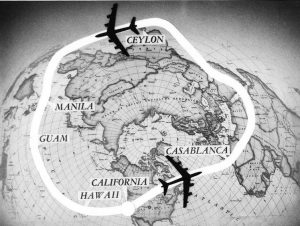 80 seconds. The 24,325 miles flight was completed at an average speed of 525 miles per hour and was completed in less than half the time required by Lucky Lady II when it made the first non-stop circumnavigation in 1949. General Curtis LeMay was among the 1,000 on hand to greet the three planes, and he awarded all 27 crew members the Distinguished Flying Cross. Though Old called the flight “a routine training mission,” the Air Force emphasized that the mission demonstrated its “capability to drop a hydrogen bomb anywhere in the world.” The flight was in reality, a warning to hostile nations, that the United States was capable of dropping a bomb anywhere in the world, and it would be for the best if these nations did not provoke the United States.
80 seconds. The 24,325 miles flight was completed at an average speed of 525 miles per hour and was completed in less than half the time required by Lucky Lady II when it made the first non-stop circumnavigation in 1949. General Curtis LeMay was among the 1,000 on hand to greet the three planes, and he awarded all 27 crew members the Distinguished Flying Cross. Though Old called the flight “a routine training mission,” the Air Force emphasized that the mission demonstrated its “capability to drop a hydrogen bomb anywhere in the world.” The flight was in reality, a warning to hostile nations, that the United States was capable of dropping a bomb anywhere in the world, and it would be for the best if these nations did not provoke the United States.
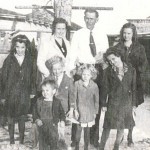 Being the youngest of my grandparents, George and Hattie Byer’s three middle children, might possibly afford my Uncle Wayne Byer a small amount of innocence in the antics the three of them pulled, but if you know Uncle Wayne, you would be hard pressed to buy into that idea, because the three of them, Uncle Larry Byer, the oldest; my mother, Collene Spencer, the middle child; and Uncle Wayne were pretty much equally to blame. I really think they drove my grandmother half crazy. What one didn’t pull, another did. They would defend each other to the end…or until Grandma got a hold of them, then all bets were off.
Being the youngest of my grandparents, George and Hattie Byer’s three middle children, might possibly afford my Uncle Wayne Byer a small amount of innocence in the antics the three of them pulled, but if you know Uncle Wayne, you would be hard pressed to buy into that idea, because the three of them, Uncle Larry Byer, the oldest; my mother, Collene Spencer, the middle child; and Uncle Wayne were pretty much equally to blame. I really think they drove my grandmother half crazy. What one didn’t pull, another did. They would defend each other to the end…or until Grandma got a hold of them, then all bets were off.

They all three had a great sense of humor, but sometimes I think that Uncle Wayne had the best one…or maybe it was that he just had a way of connecting with the kids in the family. That could easily be it, but he was definitely a big part of the three “partners in crime” that was my mom and her two brothers. I know that all kids can be a trial for parents, but I have a feeling that these three might have really tried my grandmother’s patience, and as if that wasn’t enough, there were six other children in the house too. There was lots of talent, from singing, to dancing, but partners in crime took the cake in the antics department.
 Of course, by the time I met my Uncle Wayne, he was a grown man, who’s oldest son was just two years younger than I was. All the older kids knew about it, but as the younger ones came along, we were always treated to Uncle Wayne’s signature prank…for lack of a better word. He would pop out his dentures, and encourage us to try…which we, of course did, without success. Uncle Wayne’s laugh was infectious. He just had a way of getting all of the kids laughing too. Everyone of the kids loved the uncles. They were really kids at heart…all their lives, and Uncle Wayne, being the only one left has carried on the tradition quite well. He’s a real kick. Today is my Uncle Wayne’s 80th birthday!! Happy birthday Uncle Wayne!! Have a great day!! We love you!!
Of course, by the time I met my Uncle Wayne, he was a grown man, who’s oldest son was just two years younger than I was. All the older kids knew about it, but as the younger ones came along, we were always treated to Uncle Wayne’s signature prank…for lack of a better word. He would pop out his dentures, and encourage us to try…which we, of course did, without success. Uncle Wayne’s laugh was infectious. He just had a way of getting all of the kids laughing too. Everyone of the kids loved the uncles. They were really kids at heart…all their lives, and Uncle Wayne, being the only one left has carried on the tradition quite well. He’s a real kick. Today is my Uncle Wayne’s 80th birthday!! Happy birthday Uncle Wayne!! Have a great day!! We love you!!
 I grew up in Casper, Wyoming in the 70’s. There wasn’t a whole lot for the teen crowd to do, so we all rode “The Strip.” The Strip included all of CY Avenue and part of Center Street and 2nd Street. Most if the kids who had access to a car or knew someone who did, were out on the Strip every Friday and Saturday night. People would show off their “ride,” if they had a cool one, and meet up with their friends. My husband, Bob Schulenberg and I had lots of good friends we hooked up with on the Strip. One of our good friends was Lana Alldredge. Lana had one of those “rides” that was one to show off…a 1970 Mustang Mach 1…Canary Yellow with black stripes. She was so proud of that car. Every night before heading out to ride the Strip, Lana took her car to the carwash for a bath, because she couldn’t stand the thought of her car being dirty when people saw it. Now Lana was out of high school, and so rode the Strip every night, while my parents wouldn’t let me go out on school nights. Nevertheless, lots of kids could go out every night,
I grew up in Casper, Wyoming in the 70’s. There wasn’t a whole lot for the teen crowd to do, so we all rode “The Strip.” The Strip included all of CY Avenue and part of Center Street and 2nd Street. Most if the kids who had access to a car or knew someone who did, were out on the Strip every Friday and Saturday night. People would show off their “ride,” if they had a cool one, and meet up with their friends. My husband, Bob Schulenberg and I had lots of good friends we hooked up with on the Strip. One of our good friends was Lana Alldredge. Lana had one of those “rides” that was one to show off…a 1970 Mustang Mach 1…Canary Yellow with black stripes. She was so proud of that car. Every night before heading out to ride the Strip, Lana took her car to the carwash for a bath, because she couldn’t stand the thought of her car being dirty when people saw it. Now Lana was out of high school, and so rode the Strip every night, while my parents wouldn’t let me go out on school nights. Nevertheless, lots of kids could go out every night, 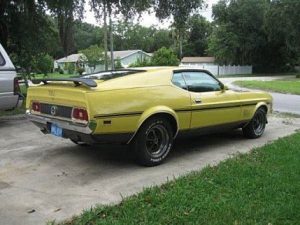 so her car was one that was well known, and had the reputation of always being clean, shiny, and tricked out. If you rode the Strip, you knew Lana’s car.
so her car was one that was well known, and had the reputation of always being clean, shiny, and tricked out. If you rode the Strip, you knew Lana’s car.
I read somewhere that in Minnetonka, Minnesota, there is a law, currently on the books that would work well for Lana, but not so much for most people. According to section 845.110 of Minnetonka, Minnesota’s city laws, there are several situations that are deemed a “public nuisance”, including but certainly not limited to ” a truck or other vehicle whose wheels or tires deposit mud, dirt, sticky substances, litter or other material on any street or highway“. Now, if you ask me, that is extreme. The only way to never have dirty tires is pretty much to bathe your vehicle constantly. While someone like Lana would be ok with that in her Mach 1 years, most people can’t see the point in a daily car bath, just so they didn’t get dirt on the street…in fact, the law is simply, outrageously insane, if you ask me.
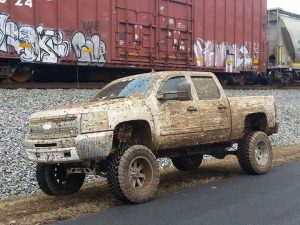 I agree with city beautification, and I can see not wanting the citizens throw shovel loads of dirt or mud onto the city streets, but lets face it…the wind probably deposits more, dirt and litter that the car tires do. Dirty tires, seem more like a relatively unavoidable consequence, rather than considering it a public nuisance, which is defined as something that disturbs peace, safety, and/or general welfare. Dirty tires are a little bit of a stretch here. On the other hand, there really aren’t many things that are less appealing than a dirty truck, especially when it has dirty tires, so maybe this law was founded on some good principles. Still, if this is a law that is still enforced, I don’t think I would want to live in Minnetonka, Minnesota.
I agree with city beautification, and I can see not wanting the citizens throw shovel loads of dirt or mud onto the city streets, but lets face it…the wind probably deposits more, dirt and litter that the car tires do. Dirty tires, seem more like a relatively unavoidable consequence, rather than considering it a public nuisance, which is defined as something that disturbs peace, safety, and/or general welfare. Dirty tires are a little bit of a stretch here. On the other hand, there really aren’t many things that are less appealing than a dirty truck, especially when it has dirty tires, so maybe this law was founded on some good principles. Still, if this is a law that is still enforced, I don’t think I would want to live in Minnetonka, Minnesota.
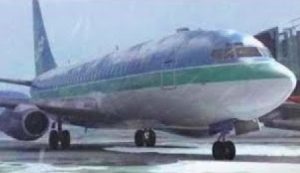 January 13, 1982 found Washington DC in the middle of a severe snowstorm. The Washington National Airport was closed due to heavy snowfall…in excess of 6.5 inches. The airport reopened at noon under barely marginal conditions, but decreasing snow. The planes that had been waiting, began the de-icing process, including an Air Florida Boeing 727. The plane had flown into Washington from Miami in the early afternoon and was supposed to return to Fort Lauderdale, Florida, after a short stop. The short layover turned into a much longer one when the airport closed. When it reopened, the plane was de-iced with chemical anti-freeze, but the planes still had difficulty moving away from the gate due to the ice, so when it eventually made it to the airport’s only usable runway, it was forced to wait 45 minutes more for clearance to take off.
January 13, 1982 found Washington DC in the middle of a severe snowstorm. The Washington National Airport was closed due to heavy snowfall…in excess of 6.5 inches. The airport reopened at noon under barely marginal conditions, but decreasing snow. The planes that had been waiting, began the de-icing process, including an Air Florida Boeing 727. The plane had flown into Washington from Miami in the early afternoon and was supposed to return to Fort Lauderdale, Florida, after a short stop. The short layover turned into a much longer one when the airport closed. When it reopened, the plane was de-iced with chemical anti-freeze, but the planes still had difficulty moving away from the gate due to the ice, so when it eventually made it to the airport’s only usable runway, it was forced to wait 45 minutes more for clearance to take off.
Not wanting to further delay the flight, the pilot, Larry Wheaton, did not return to the terminal for more de-icing, and worse, failed to turn on the plane’s own de-icing system. In fact, the pilot and co-pilot actually discussed the situation, and the co-pilot said “It’s a losing battle trying to de-ice these things. It gives you a false sense of security, that’s all it does.” During the delay, however, ice was accumulating on the wings, and 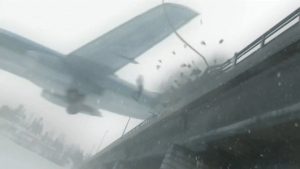 by the time the plane reached the end of the runway, it was able to achieve only a few hundred feet of altitude.
by the time the plane reached the end of the runway, it was able to achieve only a few hundred feet of altitude.
The Air Florida flight took off from Washington National Airport in Arlington, Virginia, with 74 passengers and 5 crew members on board. Thirty seconds later, the plane crashed into the 14th Street Bridge over the Potomac River, less than a mile away from the runway. Seven vehicles traveling on the bridge were struck by the 727 and the plane fell into the freezing water. It was later determined that 73 of the people on board the plane died from the impact, leaving only six survivors in the river. In addition, four motorists, who had been on the bridge, died in the crash. Terrible traffic in Washington that day made it almost impossible for rescue workers to reach the scene. Witnesses didn’t know what to do to assist the survivors who were stuck in the freezing river. Finally, a police helicopter arrived and began assisting the survivors in a very risky operation.
Two people in particular emerged as heroes during the rescue…Arland Williams and Lenny Skutnik. Known as 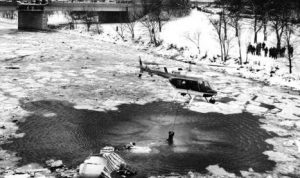 the “sixth passenger,” Williams survived the crash, and passed lifelines on to others rather than take one for himself. He ended up being the only plane passenger to die from drowning. When one of the survivors to whom Williams had passed a lifeline was unable to hold on to it, Skutnik, who was watching the unfolding tragedy, jumped into the water and swam to rescue her. Both Skutnik and Williams, along with bystander Roger Olian, received the Coast Guard Gold Lifesaving Medal. The bridge was later renamed the Arland D. Williams Jr. Memorial Bridge. It was a completely preventable tragedy, and all because they got in a hurry.
the “sixth passenger,” Williams survived the crash, and passed lifelines on to others rather than take one for himself. He ended up being the only plane passenger to die from drowning. When one of the survivors to whom Williams had passed a lifeline was unable to hold on to it, Skutnik, who was watching the unfolding tragedy, jumped into the water and swam to rescue her. Both Skutnik and Williams, along with bystander Roger Olian, received the Coast Guard Gold Lifesaving Medal. The bridge was later renamed the Arland D. Williams Jr. Memorial Bridge. It was a completely preventable tragedy, and all because they got in a hurry.
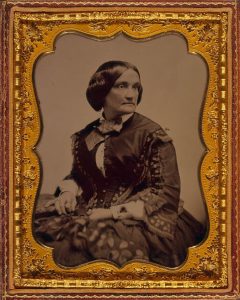 The Ambrotype (from the Ancient Greek words for immortal or impression) or Amphitype, also known as a collodion positive in England, is a positive photograph on glass made by a variant of the wet plate collodion process. Like a print on paper, it is viewed by reflected light. Like the Daguerreotype, which it replaced, and like the prints produced by a Polaroid camera, each is a unique original that could only be duplicated by using a camera to copy it.
The Ambrotype (from the Ancient Greek words for immortal or impression) or Amphitype, also known as a collodion positive in England, is a positive photograph on glass made by a variant of the wet plate collodion process. Like a print on paper, it is viewed by reflected light. Like the Daguerreotype, which it replaced, and like the prints produced by a Polaroid camera, each is a unique original that could only be duplicated by using a camera to copy it.
The Ambrotype was introduced in the 1850s. Then, during the 1860s it was replaced by the tintype, a similar photograph on thin black-lacquered iron, hard to distinguish from an Ambrotype, if under glass. It is quite the process. One side of a clean glass plate was coated with a thin layer of iodized collodion; which is a flammable, syrupy solution of pyroxylin (also known as “nitrocellulose,” “cellulose nitrate,” “flash paper,” and “gun cotton”) in ether and alcohol. The glass is then dipped in a silver nitrate solution. The plate was exposed in the camera while still wet. Exposure times varied from five to sixty seconds or more depending on the brightness of the lighting and the speed of the camera lens. The plate was then developed and fixed. The resulting negative, when viewed by reflected light against a black background, appears to be a positive image: the clear areas look black, and the exposed, opaque areas appear relatively light. This effect was integrated by backing the plate with black velvet; by taking the 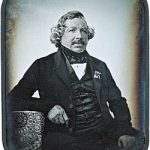 picture on a plate made of dark reddish-colored glass (the result was called a ruby Ambrotype); or by coating one side of the plate with black varnish. Either the emulsion side or the bare side could be coated: if the bare side was blackened, the thickness of the glass added a sense of depth to the image. In either case, another plate of glass was put over the fragile emulsion side to protect it, and the whole was mounted in a metal frame and kept in a protective case. In some instances the protective glass was cemented directly to the emulsion, generally with a balsam resin. This protected the image well but tended to darken it. Ambrotypes were sometimes hand-tinted; untinted ambrotypes are monochrome, gray or tan in their lightest areas.
picture on a plate made of dark reddish-colored glass (the result was called a ruby Ambrotype); or by coating one side of the plate with black varnish. Either the emulsion side or the bare side could be coated: if the bare side was blackened, the thickness of the glass added a sense of depth to the image. In either case, another plate of glass was put over the fragile emulsion side to protect it, and the whole was mounted in a metal frame and kept in a protective case. In some instances the protective glass was cemented directly to the emulsion, generally with a balsam resin. This protected the image well but tended to darken it. Ambrotypes were sometimes hand-tinted; untinted ambrotypes are monochrome, gray or tan in their lightest areas.
The Ambrotype was based on the wet plate collodion process invented by Frederick Scott Archer. Ambrotypes were deliberately underexposed negatives made by that process and optimized for viewing as positives instead. In the United States, ambrotypes first came into use in the early 1850s. In 1854, James Ambrose Cutting of 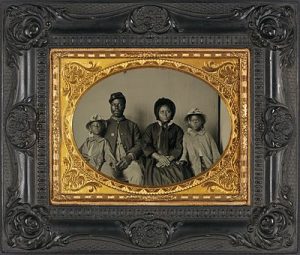 Boston took out several patents relating to the process. He may be responsible for coining the term “Ambrotype.” Ambrotypes were much less expensive to produce than daguerreotypes, the medium that predominated when they were introduced, and did not have the bright mirror-like metallic surface that could make daguerreotypes troublesome to view and which some people disliked. An Ambrotype, however, appeared dull and drab when compared with the brilliance of a well-made and properly viewed daguerreotype. It’s amazing to me that photography could be so complicated…especially when you think that these days, everything is digital, and errors can easily be fixed with Photoshop.
Boston took out several patents relating to the process. He may be responsible for coining the term “Ambrotype.” Ambrotypes were much less expensive to produce than daguerreotypes, the medium that predominated when they were introduced, and did not have the bright mirror-like metallic surface that could make daguerreotypes troublesome to view and which some people disliked. An Ambrotype, however, appeared dull and drab when compared with the brilliance of a well-made and properly viewed daguerreotype. It’s amazing to me that photography could be so complicated…especially when you think that these days, everything is digital, and errors can easily be fixed with Photoshop.
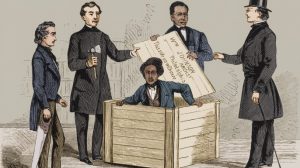 There are times when what you know is what gets you through a bad situation, but there are some situations that really do requiring knowing someone who can help. For the slaves in the pre-emancipation era of the United States, that was as true as it gets. The slaves had none of the most important asset needed for escape…money. That didn’t stop the attempts. One slave who was from the deeper south, Henry “Box” Brown, decided to mail himself to safety. That did work, but not everyone had the ability to get that done, and so the majority just decided to make a run for it…only to be met by dogs or Bounty Hunters…neither was going to have a good outcome.
There are times when what you know is what gets you through a bad situation, but there are some situations that really do requiring knowing someone who can help. For the slaves in the pre-emancipation era of the United States, that was as true as it gets. The slaves had none of the most important asset needed for escape…money. That didn’t stop the attempts. One slave who was from the deeper south, Henry “Box” Brown, decided to mail himself to safety. That did work, but not everyone had the ability to get that done, and so the majority just decided to make a run for it…only to be met by dogs or Bounty Hunters…neither was going to have a good outcome.
One rather famous slave named Mustapha, teamed up with a white hunchback named Arthur Howe and conned his way to freedom. It was probably the most outrageous, and yet the best planned escape there was. The plan was simple, the pair traveled through North Carolina and Virginia, telling anyone they met that Mustapha was Howe’s slave. Since Howe was famous for his fearsome appearance and “expressive of dark angry passions,” that few people dared to ask any more questions. Whenever Howe and Mustapha, reached a town, Howe would sell Mustapha for a tidy fee. After a few days recuperating, Mustapha would escape again and the partners would resume their journey. Not only did this help avoid bounty hunters, who would be looking for an escaped slave, rather than a current one, it brought in a tidy profit as well. Mustapha was quite a brave man. He was not worried that he would not be able to escape the people he was sold too. Most slaves struggled to escape once…Mustapha did it every week. 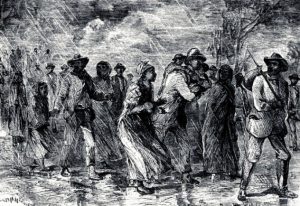 He also had to trust Howe to continue to be there waiting for him so they could continue their journey.
He also had to trust Howe to continue to be there waiting for him so they could continue their journey.
The plan worked perfectly and as planned the pair parted ways, after reaching Petersburg or Richmond. This put Mustapha free to make his escape north. Since he was not apprehended, it is believed that this was what happened. No one is exactly positive about that, but the duo dropped out of history after that, so it is believed to be the way everything went down. When we look back on the many deaths that followed an escape attempt, I have to think that it is sad that more slaves didn’t think of this idea. I’m sure the many slave owners who were scammed though, I think there was a little justice in the world after all.

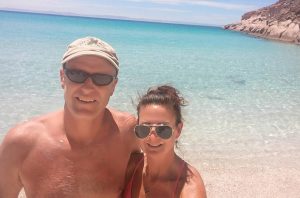 My niece, Toni Chase has become a world traveler since her marriage to Dave. She and Dave love going places. Whether it’s Hawaii, or the Caribbean, they spend as much time traveling as they can. They decided to get a time share, and while most people who have a time share, end up selling it because they don’t really use it, that is not the case with Toni and Dave. They love theirs and they use it often. They just pick a date, and look and the available sites, and register for their dates. If a person thinks they like to travel, but really isn’t sure, time shares are probably not the best thing to have, but for Toni and Dave, it was perfect, and they use it a lot. in fact, they went to Mexico in June.
My niece, Toni Chase has become a world traveler since her marriage to Dave. She and Dave love going places. Whether it’s Hawaii, or the Caribbean, they spend as much time traveling as they can. They decided to get a time share, and while most people who have a time share, end up selling it because they don’t really use it, that is not the case with Toni and Dave. They love theirs and they use it often. They just pick a date, and look and the available sites, and register for their dates. If a person thinks they like to travel, but really isn’t sure, time shares are probably not the best thing to have, but for Toni and Dave, it was perfect, and they use it a lot. in fact, they went to Mexico in June.
For Toni, family comes first. Her boys are the most important part of her life. She had a son, James Renville from her first marriage, and while Dave loves James, and is a big part of his life, he would never try to replace James’ real dad. I think it is the respect shown on both sides of that split, that has made it a very good relationship for all of them. Of course, a good relationship between blended families is only possible if everyone works together, and for this group the respect, cooperation, and a genuine love for James. And isn’t that really what good parents do…the best thing for the kids.
This has been an interesting year for Toni. Dave has spent much of his time playing softball and basketball, and 
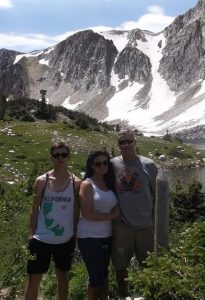 apparently that’s a little hard on Toni. I don’t know if it was heavy duty cheering, or what, but Toni ended up having hernia surgery. During the surgery, they found that the appendix was caught in the hernia, and it had to be removed too. It wasn’t Dave’s sports that caused Toni’s need for surgery, but Toni is a great cheerleader when it come to the sports and activities of her boys. I think she pretty much likes anything they are doing. Of course when it comes to what Toni is doing, Dave like most husbands, Dave couldn’t tell you what she has been up to. Toni has recently become interested in Wyoming history. Maybe she is a chip off of her Aunt Caryn’s block. She says that it’s very addictive. I agree. Today is Toni’s birthday. Happy birthday Toni!! Have a great day!! We love you!!
apparently that’s a little hard on Toni. I don’t know if it was heavy duty cheering, or what, but Toni ended up having hernia surgery. During the surgery, they found that the appendix was caught in the hernia, and it had to be removed too. It wasn’t Dave’s sports that caused Toni’s need for surgery, but Toni is a great cheerleader when it come to the sports and activities of her boys. I think she pretty much likes anything they are doing. Of course when it comes to what Toni is doing, Dave like most husbands, Dave couldn’t tell you what she has been up to. Toni has recently become interested in Wyoming history. Maybe she is a chip off of her Aunt Caryn’s block. She says that it’s very addictive. I agree. Today is Toni’s birthday. Happy birthday Toni!! Have a great day!! We love you!!

 My niece, Gabby Beach finished her service in the Navy, and now it is her time to finish her education. Gabby was a corpsman in the Navy, and so have decided to go for a nursing degree. She and her husband, Allen decided to make Casper, Wyoming their home for the college years, because Casper College has a great nursing program, and it places them close to family…something they haven’t had since they joined the Navy. This semester will find Gabby taking the prerequisites, for the nursing program, which is no small class load. In addition, she will be taking a PE class, which, for Gabby, is a walk in the park. She is a fitness fanatic. She looks great, and she could take on any physical challenge issued. In fact, she is also taking the certification to become a personal trainer. I think it would be very easy for Gabby to have three careers. Nursing, Personal Trainer, and Dog Training for service dogs. She is quite good at all three.
My niece, Gabby Beach finished her service in the Navy, and now it is her time to finish her education. Gabby was a corpsman in the Navy, and so have decided to go for a nursing degree. She and her husband, Allen decided to make Casper, Wyoming their home for the college years, because Casper College has a great nursing program, and it places them close to family…something they haven’t had since they joined the Navy. This semester will find Gabby taking the prerequisites, for the nursing program, which is no small class load. In addition, she will be taking a PE class, which, for Gabby, is a walk in the park. She is a fitness fanatic. She looks great, and she could take on any physical challenge issued. In fact, she is also taking the certification to become a personal trainer. I think it would be very easy for Gabby to have three careers. Nursing, Personal Trainer, and Dog Training for service dogs. She is quite good at all three.
Another nice thing about moving to Wyoming for school, is the fact that there are lots of places to go hiking, and that is something that Gabby and Allen like to do. They have traveled the world, and I’m sure they have hiked lots of places too. I’m sure that Wyoming is pretty unique when compared to the places they have lived. While Wyoming has its own kind of beauty, I’m sure it is much more rustic than any other place they have lived. They have settled in an apartment on my sister, Caryl Reed, and her husband Mike’s retirement home outside of Casper, and they are really enjoying the quietness of country living. I don’t think that any of the places Gabby has lived before go much snow, and she was out shoveling and seemingly having a good time 
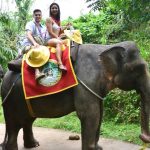 doing it. Most of us, who have lived in Wyoming for any length of time, know that shoveling snow is pretty low on the list of things most fun to do. But, once again, Gabby has proven that she is not most people. She tends to embrace to unknown or unusual.If she were like most people, I have a feeling that she would not have loved to exercise either. I have a feeling that it was Gabby’s uniqueness that first attracted Allen to her…other that her beauty. And Gabby is beautiful. Today is Gabby’s birthday. Happy birthday Gabby!! Have a great day!! We love you!!
doing it. Most of us, who have lived in Wyoming for any length of time, know that shoveling snow is pretty low on the list of things most fun to do. But, once again, Gabby has proven that she is not most people. She tends to embrace to unknown or unusual.If she were like most people, I have a feeling that she would not have loved to exercise either. I have a feeling that it was Gabby’s uniqueness that first attracted Allen to her…other that her beauty. And Gabby is beautiful. Today is Gabby’s birthday. Happy birthday Gabby!! Have a great day!! We love you!!
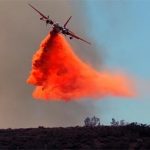 The Vietnam war was many things, but I don’t think anyone really expected Operation Ranch Hand…at least not the general public. Who would have expected such a heinous act to be carried out by the government. Operation Ranch Hand was a United States military operation during the Vietnam War, lasting from 1962 until 1971. The operation was largely inspired by the British use of 2,4,5-T and 2,4-D (Agent Orange) during the Malayan Emergency in the 1950s. It was part of the overall program during the war called “Operation Trail Dust.” Ranch Hand involved spraying an estimated 20 million United States gallons of defoliants and herbicides over rural areas of South Vietnam in an attempt to deprive the Viet Cong of food and vegetation cover. Nearly 20,000 sorties were flown between 1961 and 1971.
The Vietnam war was many things, but I don’t think anyone really expected Operation Ranch Hand…at least not the general public. Who would have expected such a heinous act to be carried out by the government. Operation Ranch Hand was a United States military operation during the Vietnam War, lasting from 1962 until 1971. The operation was largely inspired by the British use of 2,4,5-T and 2,4-D (Agent Orange) during the Malayan Emergency in the 1950s. It was part of the overall program during the war called “Operation Trail Dust.” Ranch Hand involved spraying an estimated 20 million United States gallons of defoliants and herbicides over rural areas of South Vietnam in an attempt to deprive the Viet Cong of food and vegetation cover. Nearly 20,000 sorties were flown between 1961 and 1971.
It’s hard to say if the government knew the consequences of the chemicals that were used. It’s possible that the chemicals were thought to just kill vegetation, and not to hurt people. The people involved were known as  Ranch Handers. I seriously doubt that at some point they didn’t wonder if what they were doing could possibly be harmful to the people they were spraying it on or near. Nevertheless, the “Ranch Handers” had a motto, “Only you can prevent a forest.” It was a take on the popular United States Forest Service poster slogan of Smokey Bear. During the ten years of spraying, over 5 million acres of forest and 500,000 acres of crops were heavily damaged or destroyed. Around 20% of the forests of South Vietnam were sprayed at least once.
Ranch Handers. I seriously doubt that at some point they didn’t wonder if what they were doing could possibly be harmful to the people they were spraying it on or near. Nevertheless, the “Ranch Handers” had a motto, “Only you can prevent a forest.” It was a take on the popular United States Forest Service poster slogan of Smokey Bear. During the ten years of spraying, over 5 million acres of forest and 500,000 acres of crops were heavily damaged or destroyed. Around 20% of the forests of South Vietnam were sprayed at least once.
The herbicides were sprayed by the United States Air Force flying C-123s using the call sign “Hades.” The planes were fitted with specially developed spray tanks with a capacity of 1,000 United States gallons of herbicides. A plane sprayed a swath of land that was ½ mile wide and 10 miles long in about 4½ minutes, at a rate of about 3 United States gallons per acre. Sorties usually consisted of three to five airplanes flying side by 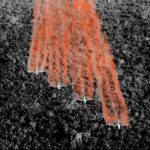 side, and 95% of the herbicides and defoliants used in the war were sprayed by the United States Air Force as part of Operation Ranch Hand. The remaining 5% were sprayed by the United States Chemical Corps, other military branches, and the Republic of Vietnam using hand sprayers, spray trucks, helicopters and boats, primarily around United States military installations…meaning that the majority of the chemicals were exposed to the Untied States Military. Many of the Vietnam veterans have felt betrayed by their own government. Many have felt that the government was well aware of the dangers of the chemicals they were spraying. I don’t know if they knew or not, but it seems like they should have suspected something. Years later, the effects of Agent Orange are well known and it was vicious.
side, and 95% of the herbicides and defoliants used in the war were sprayed by the United States Air Force as part of Operation Ranch Hand. The remaining 5% were sprayed by the United States Chemical Corps, other military branches, and the Republic of Vietnam using hand sprayers, spray trucks, helicopters and boats, primarily around United States military installations…meaning that the majority of the chemicals were exposed to the Untied States Military. Many of the Vietnam veterans have felt betrayed by their own government. Many have felt that the government was well aware of the dangers of the chemicals they were spraying. I don’t know if they knew or not, but it seems like they should have suspected something. Years later, the effects of Agent Orange are well known and it was vicious.
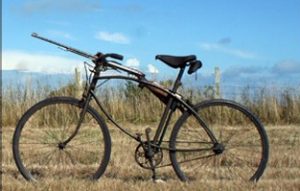
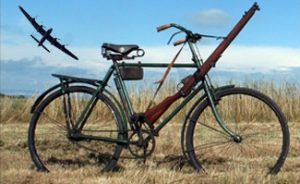 When we think about war machines, we think of planes, tanks, ships, and even horses, but we very seldom…if ever, think of bicycles. Nevertheless, bicycles were used in a number of wars, and even continue to be used to this day. The late 19th century brought several experiments into the possible role of bicycles and cycling within military establishments, primarily because they can carry more equipment and travel longer distances than walking soldiers could. The development of pneumatic tires coupled with shorter, sturdier frames in the late 19th century led military establishments to investigate the possibility of bicycles in combat. To some extent, bicyclists took over the functions of dragoons, especially as messengers and scouts, substituting for horses in warfare. Bicycle units or detachments were in existence by the end of the 19th century in most armies.
When we think about war machines, we think of planes, tanks, ships, and even horses, but we very seldom…if ever, think of bicycles. Nevertheless, bicycles were used in a number of wars, and even continue to be used to this day. The late 19th century brought several experiments into the possible role of bicycles and cycling within military establishments, primarily because they can carry more equipment and travel longer distances than walking soldiers could. The development of pneumatic tires coupled with shorter, sturdier frames in the late 19th century led military establishments to investigate the possibility of bicycles in combat. To some extent, bicyclists took over the functions of dragoons, especially as messengers and scouts, substituting for horses in warfare. Bicycle units or detachments were in existence by the end of the 19th century in most armies.
By World War I, the level terrain in Belgian was well used by military cyclists, prior to the onset of trench 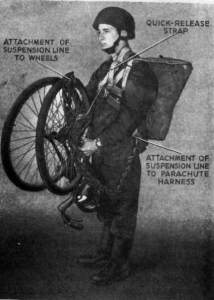 warfare. Each of the four Belgian carabinier battalions included a company of cyclists, equipped with a brand of folding, portable bicycle named the Belgica. A regimental cyclist school gave training in map reading, reconnaissance, reporting, and the carrying of verbal messages. Attention was paid to the maintenance and repair of the machine itself. The bicycle could be used to ride when it was feasible, and carried when the pat was not suitable to riding. The bicycle made no noise, so unless the trail was littered with twigs, the bicycle make very little noise. Sneaking up on the enemy was possible.
warfare. Each of the four Belgian carabinier battalions included a company of cyclists, equipped with a brand of folding, portable bicycle named the Belgica. A regimental cyclist school gave training in map reading, reconnaissance, reporting, and the carrying of verbal messages. Attention was paid to the maintenance and repair of the machine itself. The bicycle could be used to ride when it was feasible, and carried when the pat was not suitable to riding. The bicycle made no noise, so unless the trail was littered with twigs, the bicycle make very little noise. Sneaking up on the enemy was possible.
In the United States, the most extensive experimentation on bicycle units was carried out by 1st Lieutenant Moss, of the 25th United States Infantry (Colored), which was made up of African American infantry soldiers with European American officers. Using a variety of cycle models, Moss and his troops carried out extensive bicycle journeys covering between 800 and 1,900 miles. Late in the 19th century, the United States Army tested the bicycle’s suitability for cross-country troop transport. Buffalo Soldiers stationed in Montana rode bicycles across roadless landscapes for hundreds of miles at high speed. The “wheelmen” traveled the 1,900 Miles to Saint Louis, Missouri in 34 days with an average speed of over 6 miles per hour. The bicycles were even used in the paratrooper deployment. These bicycles not only folded up, but they were equipped with an on board rifle. I don’t know how hard it was to handle a gun while riding a bike, but I’m sure it was a relief to have your gun right there.
The first known use of the bicycle in combat occurred during the Jameson Raid, in which cyclists carried messages. In the Second Boer War, military cyclists were used primarily as scouts and messengers. One unit  patrolled railroad lines on specially constructed tandem bicycles that were fixed to the rails. Several raids were conducted by cycle-mounted infantry on both sides; the most famous unit was the Theron se Verkenningskorps (Theron Reconnaissance Corps) or TVK, a Boer unit led by the scout Daniel Theron, whom British commander Lord Roberts described as “the hardest thorn in the flesh of the British advance.” Roberts placed a reward of £1,000 on Theron’s head…dead or alive…and dispatched 4,000 soldiers to find and eliminate the TVK. While scouting alone on a road near Gatsrand, about 3.7 miles north of present-day Fochville, he encountered seven members of Marshall’s Horse and was killed in action.
patrolled railroad lines on specially constructed tandem bicycles that were fixed to the rails. Several raids were conducted by cycle-mounted infantry on both sides; the most famous unit was the Theron se Verkenningskorps (Theron Reconnaissance Corps) or TVK, a Boer unit led by the scout Daniel Theron, whom British commander Lord Roberts described as “the hardest thorn in the flesh of the British advance.” Roberts placed a reward of £1,000 on Theron’s head…dead or alive…and dispatched 4,000 soldiers to find and eliminate the TVK. While scouting alone on a road near Gatsrand, about 3.7 miles north of present-day Fochville, he encountered seven members of Marshall’s Horse and was killed in action.

